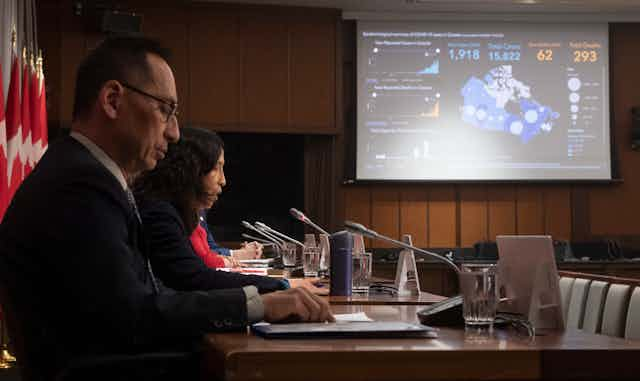Daily briefings by public health officials on the coronavirus pandemic have become must-see events for Canadians. Almost every hour of every day we are bombarded with critical information about COVID-19: how many new cases, how many hospitalized, how many tested, how many recovered and, sadly, how many deaths.
There is no question that Canadians owe a huge debt of gratitude to the front-line workers who treat the sick, keep us secure and maintain the supply chains that feed our families. It is also certain that, as of yet, we have no treatment or vaccine available to effectively stop the spread of the contagion or reduce its effects.
In this context — as any public health physician would tell you — data is our most valuable ally. Monitoring rates of infection and taking measures to reduce exposure are essential to reducing the numbers of infected over longer periods of time, often referred to as “flattening the curve.”
Read more: How to flatten the curve of coronavirus, a mathematician explains
Data on the availability of intensive care beds, respirators and protective equipment for doctors and nurses help us to plan effectively for surges in hospitalization. Data on the location of outbreaks help to protect vulnerable populations or to contain the spread of infection across regions.
Data feeds models
Such data feed the models that public health officials rely on to determine who will be subject to self-isolation and, for millions of Canadians, when and how they will be able to return to their normal lives.
The promise of accurate, informative and shared data is boundless. The reality of the global data we have, however, is that it is inaccurate, incomplete, withheld — and sometimes even corrupt.

We are facing this generational challenge precisely at the time when we have the ability to gather, share and analyze data on a scale that was unimaginable even two decades ago.
To minimize suffering and the loss of human life, we must commit to the transparent and open sharing of data. Our models — whether they compromise a simple regression analysis or the most complex of neural networks — depend completely on the quality and quantity of the data used to build them.
Data does not analyze itself. There is an equally important role for professionals such as data scientists and domain experts who can speak the language of data science across the disciplinary spectrum.
Modelling will help economists
Moving beyond the crisis, we will rely heavily on modelling exercises undertaken by our economists, business analysts and other social scientists who can point the way back to a healthy, tolerant and prosperous society.
This is underway. York University disaster management professor Eric Kennedy, for example, is tracking how Canadians understand and perceive the outbreak, whom they trust for information, and how they are adapting their behaviours. These essential insights will point to more effective strategies for information-sharing that can minimize the impacts of similar diseases.
At the University of Calgary, another team of researchers led by sociologist Myles Leslie, is assessing how COVID-19 preparedness and response policies are being transmitted to, and implemented in hospital and family health centres, from isolation protocols to patient triage. This work will help identify opportunities for improving ongoing and future public health emergencies.
At McGill University, medical informatics expert David Buckeridge and his team are combining natural language processing technology with machine learning tools, such as neural networks, to analyze more than two million conventional media and social media reports about the spread of the coronavirus from all over the world. The information will be combined with other data, such as COVID-19 case reports, to give policymakers and health authorities a much more complete picture of how and why the virus is spreading differently in different countries.
We all anticipate the day when effective treatments and vaccines are readily available to address the global COVID-19 threat. Until that time — and very likely in the future — data and data science will remain on the front lines of managing disease threats.
Editor’s note: The research projects mentioned in this article are part of the COVID-19 Rapid Research Fund that was announced in March. The Social Sciences and Humanities Research Council is part of that fund. Co-author Ted Hewitt is president of SSHRC.

